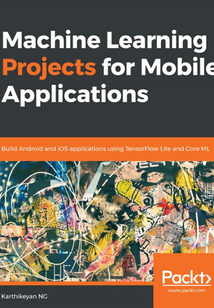首頁 > 計(jì)算機(jī)網(wǎng)絡(luò) >
硬件與維護(hù)
> Machine Learning Projects for Mobile Applications最新章節(jié)目錄
舉報(bào) 

會員
Machine Learning Projects for Mobile Applications
Machinelearningisatechniquethatfocusesondevelopingcomputerprogramsthatcanbemodifiedwhenexposedtonewdata.Wecanmakeuseofitforourmobileapplicationsandthisbookwillshowyouhowtodoso.Thebookstartswiththebasicsofmachinelearningconceptsformobileapplicationsandhowtogetwellequippedforfurthertasks.YouwillstartbydevelopinganapptoclassifyageandgenderusingCoreMLandTensorflowLite.YouwillexploreneuralstyletransferandgetfamiliarwithhowdeepCNNswork.WewillalsotakeacloserlookatGoogle’sMLKitfortheFirebaseSDKformobileapplications.Youwilllearnhowtodetecthandwrittentextonmobile.YouwillalsolearnhowtocreateyourownSnapchatfilterbymakinguseoffacialattributesandOpenCV.Youwilllearnhowtotrainyourownfoodclassificationmodelonyourmobile;allofthiswillbedonewiththehelpofdeeplearningtechniques.Lastly,youwillbuildanimageclassifieronyourmobile,compareitsperformance,andanalyzetheresultsonbothmobileandcloudusingTensorFlowLitewithanRCNN.Bytheendofthisbook,youwillnotonlyhavemasteredtheconceptsofmachinelearningbutalsolearnedhowtoresolveproblemsfacedwhilebuildingpowerfulappsonmobilesusingTensorFlowLite,Caffe2,andCoreML.
目錄(186章)
倒序
- coverpage
- Title Page
- Dedication
- Packt Upsell
- Why subscribe?
- Packt.com
- Contributors
- About the author
- About the reviewer
- Packt is searching for authors like you
- Preface
- Who this book is for
- What this book covers
- To get the most out of this book
- Download the code
- Download the color images
- Conventions used
- Get in touch
- Reviews
- Mobile Landscapes in Machine Learning
- Machine learning basics
- Supervised learning
- Unsupervised learning
- Linear regression - supervised learning
- TensorFlow Lite and Core ML
- TensorFlow Lite
- Supported platforms
- TensorFlow Lite memory usage and performance
- Hands-on with TensorFlow Lite
- Converting SavedModel into TensorFlow Lite format
- Strategies
- TensorFlow Lite on Android
- Downloading the APK binary
- TensorFlow Lite on Android Studio
- Building the TensorFlow Lite demo app from the source
- Installing Bazel
- Installing using Homebrew
- Installing Android NDK and SDK
- TensorFlow Lite on iOS
- Prerequisites
- Building the iOS demo app
- Core ML
- Core ML model conversion
- Converting your own model into a Core ML model
- Core ML on an iOS app
- Summary
- CNN Based Age and Gender Identification Using Core ML
- Age gender and emotion prediction
- Age prediction
- Gender prediction
- Convolutional Neural Networks
- Finding patterns
- Finding features from an image
- Pooling layer
- Rectified linear units
- Local response normalization layer
- Dropout layer
- Fully connected layer
- CNNs for age and gender prediction
- Architecture
- Training the network
- Initializing the dataset
- The implementation on iOS using Core ML
- Summary
- Applying Neural Style Transfer on Photos
- Artistic neural style transfer
- Background
- VGG network
- Layers in the VGG network
- Building the applications
- TensorFlow-to-Core ML conversion
- iOS application
- Android application
- Setting up the model
- Training your own model
- Building the application
- Setting up the camera and an image picker
- Summary
- References
- Deep Diving into the ML Kit with Firebase
- ML Kit basics
- Basic feature set
- Building the application
- Adding Firebase to our application
- Face detection
- Face orientation tracking
- Landmarks
- Classification
- Implementing face detection
- Face detector configuration
- Running the face detector
- Step one: creating a FirebaseVisionImage from the input
- Using a bitmap
- From media.Image
- From a ByteBuffer
- From a ByteArray
- From a file
- Step two: creating an instance of FirebaseVisionFaceDetector object
- Step three: image detection
- Retrieving information from detected faces
- Barcode scanner
- Step one: creating a FirebaseVisionImage object
- From bitmap
- From media.Image
- From ByteBuffer
- From ByteArray
- From file
- Step two: creating a FirebaseVisionBarcodeDetector object
- Step three: barcode detection
- Text recognition
- On-device text recognition
- Detecting text on a device
- Cloud-based text recognition
- Configuring the detector
- Summary
- A Snapchat-Like AR Filter on Android
- MobileNet models
- Building the dataset
- Retraining of images
- Model conversion from GraphDef to TFLite
- Gender model
- Emotion model
- Comparison of MobileNet versions
- Building the Android application
- References
- Questions
- Summary
- Handwritten Digit Classifier Using Adversarial Learning
- Generative Adversarial Networks
- Generative versus discriminative algorithms
- Steps in GAN
- Understanding the MNIST database
- Building the TensorFlow model
- Training the neural network
- Building the Android application
- FreeHandView for writing
- Digit classifier
- Summary
- Face-Swapping with Your Friends Using OpenCV
- Understanding face-swapping
- Steps in face-swapping
- Facial key point detection
- Identifying the convex hull
- Delaunay triangulation and Voronoi diagrams
- Affine warp triangles
- Seamless cloning
- Building the Android application
- Building a native face-swapper library
- Android.mk
- Application.mk
- Applying face-swapping logic
- Building the application
- Summary
- References
- Questions
- Classifying Food Using Transfer Learning
- Transfer learning
- Approaches in transfer learning
- Training our own TensorFlow model
- Installing TensorFlow
- Training the images
- Retraining with own images
- Training steps parameter
- Architecture
- Distortions
- Hyperparameters
- Running the training script
- Model conversion
- Building the iOS application
- Summary
- What's Next?
- What you have learned so far
- Where to start when developing an ML application
- IBM Watson services
- Microsoft Azure Cognitive Services
- Amazon ML
- Google Cloud ML
- Building your own model
- Limitations of building your own model
- Personalized user experience
- Better search results
- Targeting the right user
- Summary
- Further reading
- Other Books You May Enjoy
- Leave a review - let other readers know what you think 更新時間:2021-06-10 19:42:11
推薦閱讀
- 電腦組裝與維修從入門到精通(第2版)
- 基于ARM的嵌入式系統(tǒng)和物聯(lián)網(wǎng)開發(fā)
- micro:bit魔法修煉之Mpython初體驗(yàn)
- Large Scale Machine Learning with Python
- Visual Media Processing Using Matlab Beginner's Guide
- Practical Machine Learning with R
- 筆記本電腦應(yīng)用技巧
- Building 3D Models with modo 701
- 龍芯自主可信計(jì)算及應(yīng)用
- Hands-On Artificial Intelligence for Banking
- Istio服務(wù)網(wǎng)格技術(shù)解析與實(shí)踐
- 圖解計(jì)算機(jī)組裝與維護(hù)
- 電腦橫機(jī)使用與維修
- FPGA實(shí)驗(yàn)實(shí)訓(xùn)教程
- 可編程邏輯器件項(xiàng)目開發(fā)設(shè)計(jì)
- Raspberry Pi Home Automation with Arduino
- 零基礎(chǔ)輕松學(xué)修電腦主板
- Raspberry Pi Media Center
- 系統(tǒng)安裝、維護(hù)及故障排除實(shí)戰(zhàn)
- 機(jī)房工程設(shè)計(jì)施工與管理維護(hù)技術(shù)
- PlayStation?Mobile Development Cookbook
- Learning Android Game Development
- Arduino圖形化編程進(jìn)階實(shí)戰(zhàn)
- Mastering Lumion 3D
- 電腦軟硬件維修從入門到精通
- Machine Learning for Finance
- 數(shù)碼辦公設(shè)備檢修技能零基礎(chǔ)成長
- 新硬件主義
- INSTANT Prezi for Education How-to
- 設(shè)計(jì)模式就該這樣學(xué):基于經(jīng)典框架源碼和真實(shí)業(yè)務(wù)場景

